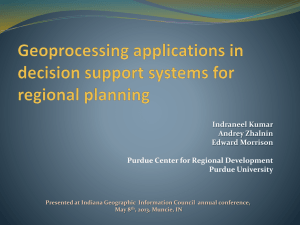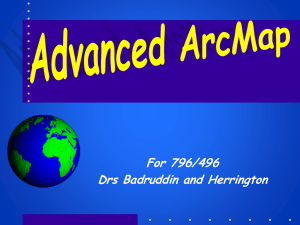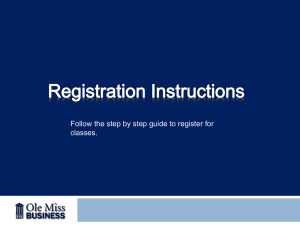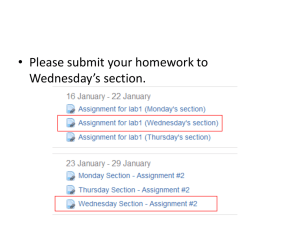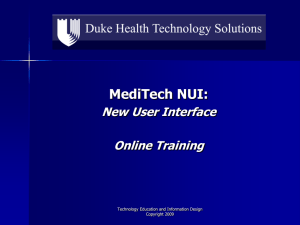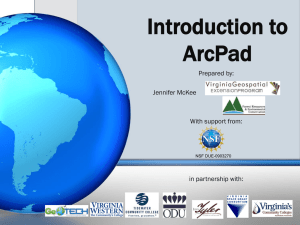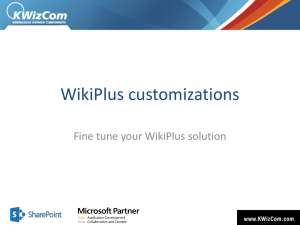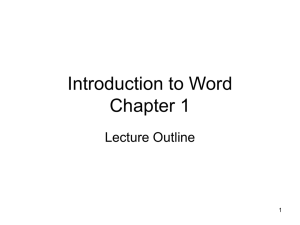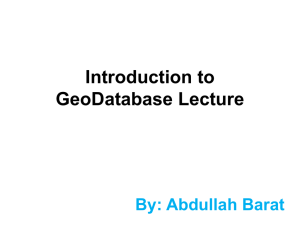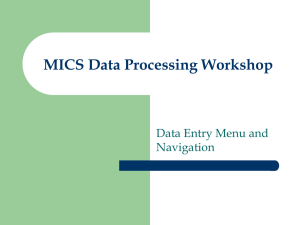What`s New in ArcGIS 10.0 - Spatial Data Management Group
advertisement
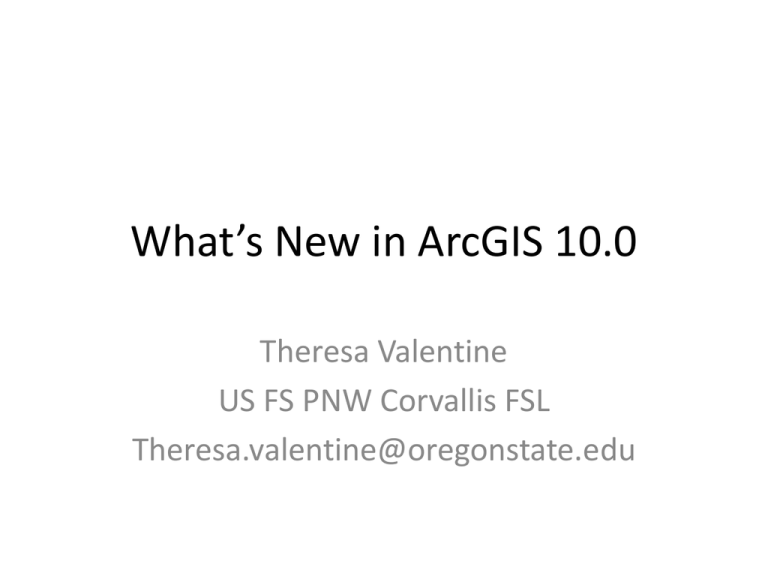
What’s New in ArcGIS 10.0 Theresa Valentine US FS PNW Corvallis FSL Theresa.valentine@oregonstate.edu Reference Material: • What’s new in ArcGIS 10: – http://help.arcgis.com/en/arcgisdesktop/10.0/pdf/ whats_new_in_arcgis_10.pdf • Desktop help: – http://help.arcgis.com/en/arcgisdesktop/10.0/help/i ndex.html#//00qp0000000p000000.htm • This Powerpoint: t:\commons\tvalentine (what’s new in there also) ArcMap Options: under customize • Raster: raster layer options: re-sampling, stretch type (min-max), set cache, clear cache, • data interoperability: write log files; • tables: set preferences; • Metadata: set the metadata style to FGDC, • General: many options ArcMap: New design • Toolbars under: Customize • Many things went away… but can be added back in: customize, customize mode – Set selectable layers: I added that to the toolbar • Geoprocessing tab: added back, you can add your favorites to it: the results window is under this tab now… Geodatabases • New format: need to upgrade: use the Upgrade geodatabase geprocessing tool or a python script. – Six new topology rules are available. • Polygon: contains one point • Line: must not intersect with, must not intersect or touch interior with, must be inside • Point: must be coincident with, must be disjoint. – You can create a current version or previous.. Create layers based on SQL queries: read only, you can save out as a layer file or layer package. New geometric network wizard (pg 34) Editing • • • • • • • • • Editor toolbar re-designed Two ways to start: clicking the editor menu on the editor toolbar or right click a layer in the table of contents. Feature templates: must create one to edit. New pop-up mini toolbars (get in the way) New snapping environment You can go back to the “classic” editor http://blogs.esri.com/Support/blogs/supportcenter/archive/2010/08/20/settingthe-edit-and-snapping-environments-in-arcgis-10-to-the-classic-9-x-format.aspx Attachments: add files to individual features and can be images, pdfs, text documents, or any other type of file. Similar to hyper-links but allow you to associate multiple files to a feature, can view from the identify window, the attributes window (when editing), in the attribute table window, and thru html pop-ups. Geodatabase must be in version 10. Absolute XY dialog box: different units: http://help.arcgis.com/en/arcgisdesktop/10.0/help/index.html#//001t0000005100 0000.htm Editing • Creating/splitting polygons: construct polygons and split polygons: trace, modify features, etc… – Intersect command removed from editor, but available in customize dialog box – Mirror features has been converted into a tool available in customize dialog box – Validate entire topology button removed from topology toolbar, but available in customize dialog box – Options for fillet tool and trace construction available by right-clicking the map, or the O key – Explode multipart features: – Feature construction toolbar (tab/shift tab) – Reshape feature tools/trace tool/select-edit vertices Raster Data • All raster formats at 10.0 use the GDAL library. • All new pyramids are saved as OVR files (exception of ERDAS IMAGINE format) • New raster data model: mosaic datasets. (personal, file, ARCSDE): functions • New geoprocessing tools (pg 7 in book) • Custom color schemes • Image Analysis Window: Under windows tab • Advanced labeling with the stretch renderer: (labeling tab on symbology tab) More Raster • New Icons – File-based data are yellow – Geodatabase data are gray – Data on the server are blue. • Accelerated rasters: (do this via the image analysis window)..right click on raster layer. Tables and Attributes • Table window displays all open attribute tables. (tabs along the bottom): can undock the tables to view more than one at a time. • Field calculator has been enhanced to work with Python scripting. • New command in table options menu to restore the field order in a table to its original ordering. • There is an edit mode icon on the bottom Tables continued • Layer Properties – Fields: options: (reset order) • Also from the table pull down menu: • Attachments: needs to be a geodatabase – need to upgrade to 10.0 geodatabase – In catalog, right click to enable attachments…caused me to crash arcgis 10 Attachment manager (click on a row) Metadata • New metadata editor dialog box • New geoprocessing tools • Can now validate on a metadata standard’s xml schema. • Now called “item description” • Can view metadata from arcmap ArcMap • Customize pull down menu replaces tools menu • Geocoding/adding xy data, and linear referencing events are in the File pull down menu in a new pull down right click menu called Add Data (I removed this because it made my machine run slower) • Graphs and reports are now in the view pull-down menu • My places has been moved to the data frame tools toolbar • Added back geoprocessing menu: can add your own favorites: select from customize, customize mode, tools and drag to toolbar. • Dockable windows: I find them hard to dock…pg 77 • Table of contents now has buttons along the top instead of tabs on the bottom. Can list by visibility • You can specify the default geodatabase you want your map to use • New search window: be careful about indexing… • Catalog window: Symbols and Styles • Search for symbols (excellent tool, but still lacking in actual search terms) • You can group symbols, you can resize the symbol selector window to see more symbols at once. • More info on page 89 • Customize on style manager under customize tab Map Display and navigation • Map Templates: (pg 84) • Basemap layers have been added. (right click under data frame) • Quickpan mode – Hardware acceleration: smoother refresh on pan and zoom operations for basemap layers – You can enable quickpan mode with the q key or by holding down the middle mouse button. – Fewer redraws.. Page layouts and data frames • Data driven pages: map books and multiple page products • Dynamic text (insert menu) • Clip to shape allows you to exclude individual layers. • Geoprocessing has been extended so you can manipulate maps, layouts, and layers through Python scripting. – Interact with map documents in batch. Temporal data: • Time tab on properties • Works in desktop and server • Time sliders to view data Reporting • Crystal reports Wizard is no longer included • Report wizard under the view menu • Exported to more formats, including PDF, HTM, RTF, TIFF, XLS, and TXT. • Report designer Selection tools/Graphs • 4 new selection tools: select by polygon, lasso, circle, and line. • Graphs available in ArcGlobe and ArcScene • Three new types of graphs: bubble, bar min and max, and polar graph. • New geoprocessing tools: (make graph, save graph) Geoprocessing and analysis • Tools execute in background, letting you continue working while the tool executes.. • Arctoolbox replaced by search window, the catalog window, and the results window (not so sure about this)… • You can add tools to any menu or toolbar. • Search and catalog window: want you to use this to find things… (wish it worked better) • Password protections for model and script tools. Python and ArcPy • Python version 2.6 • Python window replaces the command line window (page 15) • The ArcPy site package is installed with ArcGIS Tools: • Seven model-only tools added: work only in modelbuilder: calculate value, collect values, get field value, merge branch, parse path, select data, and stop • More than 50 core geoprocessing toos have been added • You can import your *.py file into the tool • Improved tools: – Clip/identify: support point on point and line on line – Buffer/clip/erase: support line features with vertical line segments. – Spatial join: process much larger datasets and most operations will complete in shorter amount of time. – More on pg. 115 Model Builder: • • • • Toolbar and menu have been updated Undo and redo are supported Model elements now have tooltips Iterators replace the series option in Model Properties. • Twelve iterators have been added: Pg 16 • Default spacing between elements has changed from 30 to 15. The functionality to export a model to JavaScript and VBScript has been removed Spatial Analyst • New python map algebra provides a rich and integrated way for performing map algebra. • Expressions can be entered into the new raster calculator tool or directly into the python window • Spatial analyst engine now has native read/write capability (not copying everything to arc grids?): using arcobjects without converting to grids. • Focal statistics tool has a new algorithm to improve performance. • Image classification toolbar • New tools: starts pg 157: – – – – Extract multi values to points (can use more than one raster) Multivariate analysis tool: Iso Cluster unsupervised classificatio Overlay: fuzzy membership and fuzzy overlay Zonal: zonal histogram, zonal statistics as table update Geostatistical Analyst • See pg 145 • 11 new geoprocessing tools: 4 new functionality, and 7 were previously only available through the geostatistical wizard or geostat toolbar. • Quick tour available ArcServer • • • • Manage Services in ArcCatalog Data Extraction tools Feature Service: allows editing through API’s MSD services support Maplex and new layer types. • Time aware layers • Expose feature attachments • Pg 129
